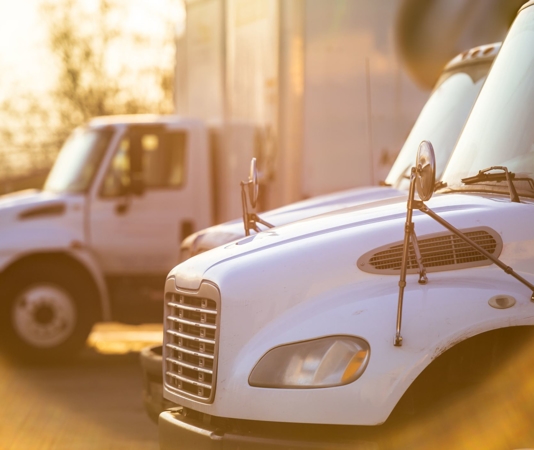Driving is dangerous, and factors like the behavior of other drivers and the types of vehicles on the roads make it so. Every driver knows that dreaded feeling of driving behind, in front of, or beside a big rig truck. Even though they are a critical part of the economy, big rig trucks are often ranked as the most dangerous vehicles on the road. There are many safety concerns when sharing the road with these vehicles, some to do with the drivers and many to do with the vehicles’ characteristics.
Longer Stopping Distances
The stopping distance of a vehicle is the distance it travels from the complete application of the brakes to when its speed goes to zero. The stopping distance is determined by the speed and weight of the vehicle, both of which are used to calculate its momentum. A higher rate of speed or higher weight means more momentum leading to a longer stopping distance.
Large trucks require a significantly longer vehicle to come to a complete stop than smaller, and therefore lighter vehicles. If a truck driver encounters a situation where they have to apply the brakes suddenly, the longer stopping distance will likely lead to a rear-end collision, an injured pedestrian, or a big rig accident resulting in serious injuries and even fatalities.
Their Weight Makes for More Serious Accidents
Being struck by a vehicle as a pedestrian, cyclist, or motorcyclist is devastating because you do not have protection around you as someone in a car does. The lack of protection means direct contact with the vehicle and these more severe injuries.
A heavy and fast-moving big rig truck has a lot more energy than a vehicle due to its higher momentum attributed to its weight. This means these big rigs cause more serious accidents and devastation than smaller vehicles or trucks.
They Have Limited Maneuverability
The average big rig is about 75 feet long. This length makes maneuverability much more challenging, especially if the driver intends to make a turn or change lanes. These trucks have a much wider turning radius than the average vehicle, and you will typically see a driver swing left before turning right. You might also think that a big rig is on the wrong lane when in fact, it is using that lane to make a turn.
These maneuvers can catch other drivers off guard, especially if they are sudden and the truck’s driver does not use their turn signals correctly.
Their limited maneuverability can also cause serious issues in parking lots, especially if there is little space for the driver to use. You might see a lot of turns as the driver tries to park their vehicle, and the time spent waiting can make drivers impatient. If you try to pass when a big rig is turning, you will likely get into an accident and can be held liable for the accident because the truck had the right of way.
Reduced Field of Vision and Blind Spots
Another common danger associated with big rigs is their limited visibility and blind spots. Reduced visibility can be in front of the truck as the driver sits up high and thus does not see cyclists or motorcyclists if they are a few feet in front of the vehicle.
Big rigs also have multiple blind spots (areas where the driver’s visibility is limited or blocked) beside and behind their trucks. The conditions on the road, such as traffic, might force you to stay in a truck’s blind spot. Since the driver cannot see you, you could get into an accident if they decide to change lanes or make a turn.
The general rule is that if you cannot see the truck driver in their side mirror, they cannot see your vehicle. Many trucks now have technology that helps drivers know a vehicle is lingering in their blind spot. If the driver has these technologies, fails to use them, and causes an accident, they could be liable, and you could be entitled to compensation.
Underride and Override
These accidents involve one vehicle going over or under another but in different orders. Underride happens when a car hits a truck from the side or behind and goes under it. Depending on the car and truck, the top of the vehicle can be crushed or ripped off completely. These car accidents are almost always fatal, with those surviving them suffering serious injuries.
Override occurs when a big rig rear-ends a vehicle, overrides its rear, and ends up on top of it. Due to the weight of a typical truck – about 80,000 pounds when loaded – the car could be completely crushed. As with underride accidents, overrides are almost always fatal.
Big Rigs Can Catch the Wind
Big rigs have two features that make them susceptible to high winds: their center of gravity and size. The size of a container makes for a larger surface area that catches the wind easily. If the wind is strong or fast enough, it can cause a truck to sway and lose balance. Due to their high center of gravity, big rigs can easily roll over, leading to a serious accident.
The Dangers of Rollovers
In addition to making them susceptible to high winds, the big rigs’ center of gravity also makes them susceptible to rolling over in different situations. The first is when the load is improperly distributed and clamped down. If not, it can move around inside the vehicle, making it unstable, with the high center of gravity making things worse.
The second is taking turns at high speeds. Any sufficiently imbalanced vehicle will roll over if the driver attempts a high-speed turn.
Because of how dangerous they are, all drivers must exercise caution, give them space and follow best practices when sharing the road with big rigs. Doing so will help mitigate the associated dangers and ensure safer interactions with these vehicles on the road.
Even in cases where drivers and other road users do everything right, they could still be involved in a big rig accident. If the accident is due to someone else’s negligence, you can pursue a claim for damages. Our attorneys at the Scarlett Law Group can help you pursue full compensation for damages.
To get started, you can visit our offices at 536 Pacific Avenue, San Francisco, CA 94133, or call us now for a free consultation at (415) 352-6264.

